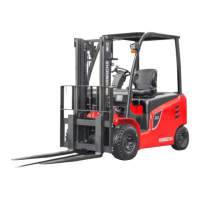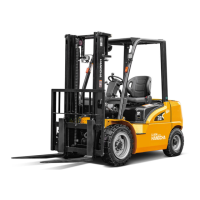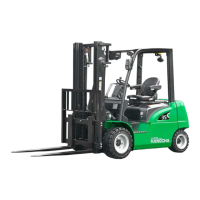Do you have a question about the HANGCHA XF Series and is the answer not in the manual?
Details on forklift gauges, indicators, and warning lights.
Identification and function of steering wheel, levers, pedals, and switches.
Description of key structural parts like the hood, overhead guard, seat, and cabin.
Pre-operation checks: fluid leaks, appearance, fuel, oil, coolant, tires.
Air cleaner maintenance and other checks based on daily maintenance.
Engine oil/filter change, tilt cylinder lubrication, gear oil check, transmission oil filter change.
Brake fluid change, steering wheel lock lubrication, hydraulic oil change, filter replacement.
Engine coolant replacement, wheel bearing grease change, steering axle gear oil change.
Maintenance on fuses, relays, and tire changes.
Key structural elements and how load, center of gravity affect stability.
Load center, mast tilt, tire pressure, speed, and surface conditions impact stability.
Relationship between maximum load and load center distance specified on load chart.
Procedures for starting diesel and gasoline engines, including preheating and warm-up.
Steps for safe travel: steering, fork positioning, checking surroundings, and gear shifting.
How to pick up loads: fork adjustment, positioning, and inserting into pallet.
Procedure for stacking loads: approaching, positioning, and lowering the load.
Steps for safely removing loads: approaching, positioning forks, and backing away.
Daily parking procedure: positioning, neutral shift, parking brake, engine shutdown.
Procedure for long-term parking: blocking wheels, removing battery, applying rust-preventive oil.
Steps to safely resume operation after extended storage: removing rust oil, draining oil, checking parts.
Schedules for engine, LPG, and drive system maintenance based on operating hours.
Table of torque values for various bolt sizes and grades.
Service life and replacement schedule for critical safety components like hoses and seals.
Recommended oils and their capacities for different forklift models and components.
Diagram showing lubrication points and recommended lubricants for various truck parts.
Diagram showing label positions on the forklift, with numbered references.
Identification of danger, hang, tonnage, and hood open labels with visual examples.
Details on diesel, gasoline, hang, operate, nameplate, and load curve labels.
Information on lubrication system, no washing, danger, and hydraulic oil labels.
Descriptions of danger, hand injury risk, antifreeze, horn, and safety belt labels.
Information on tire pressure, CE marking, LPG, and emergency stop labels.
Instructions for safely hoisting the forklift using wire ropes and lifting devices.
Guidelines for short-distance transportation and securing the forklift on ships, trains, or lorries.
Procedure for towing a damaged truck, including using the towing rod and safety precautions.
Details on cabin construction, door operation, and glass movement.
Procedure for safely dismantling cabin parts and the overhead guard assembly.
Instructions for refueling LPG cylinders and replacing them safely.
How to switch between gasoline and LPG fuel sources on dual-fuel forklifts.
Procedures for starting the engine using gasoline or LPG fuel.
Safe methods for switching fuel types while the engine is running or stopped.
Important safety notes for LPG operation, including leakage checks and temperature management.
Function and operation of the press reducing regulator for LPG systems.
Role of the mixer in combining LPG and air for engine combustion.
Function, parameters, and replacement procedures for LPG cylinders.
Step-by-step guide for safely replacing LPG cylinders, including handling and fixing.
Methods for securely fixing LPG cylinders using metal belt and buckle belt brackets.
Precautions for LPG usage, charging, storage, and maintenance of the system.
Maintenance guidelines for the LPG system, including cleaning filters and checking connections.
Safe practices for storing, transporting, and inspecting lead-acid batteries.
Procedures for maintaining, recharging, and safety measures during recharging.
Guidelines for using attachments: understanding capacity, operating methods, and safety rules.
Procedures for safely assembling attachments, ensuring correct fit and stability.
How the OPS system ensures operator presence and prevents operation when unsafe.
Identifying and addressing issues with the OPS controller, including alarms and indicator lights.
| Transmission | Automatic |
|---|---|
| Model | XF Series |
| Load Capacity | 1.0 - 3.5 tons |
| Mast Type | Duplex, Triplex (various lift heights available) |
| Lifting Height | 3000 - 6000 mm |
| Tire Type | Solid/Pneumatic |











